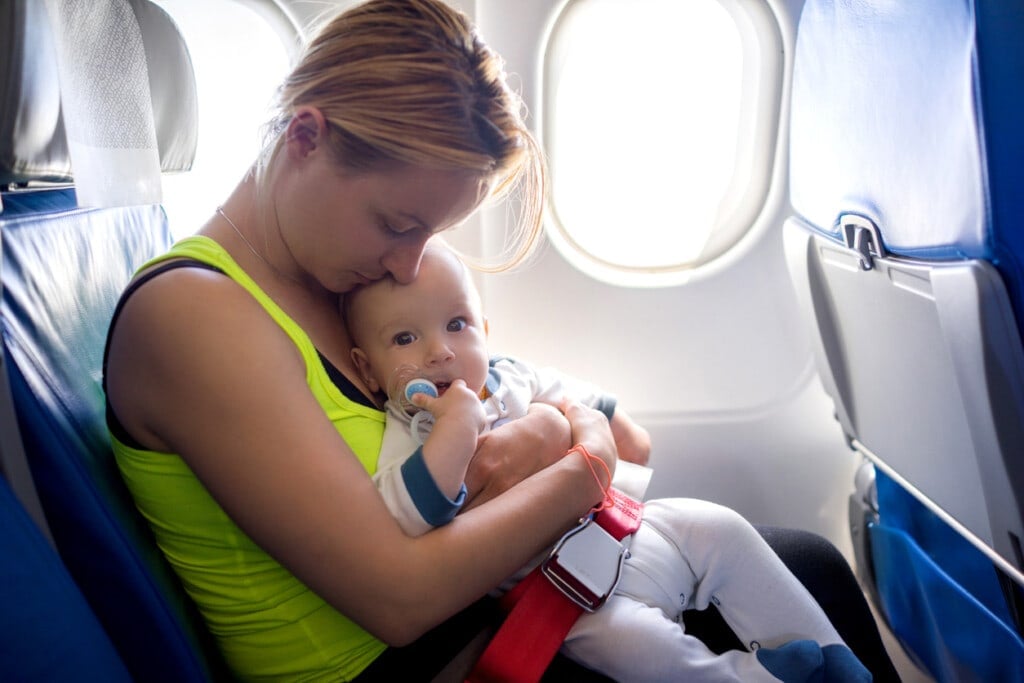If you’ve flown with a baby on an airplane, you know it’s one of the least fun things you can do with a small child. These lap babies squirm and cry, their ears pop, and you end up a sweaty, exhausted mess, questioning many of your life choices.
However, despite the horror of dealing with a blowout diaper in a tiny 12-inch wide bathroom or the embarrassment of your one-year-old chucking his toy at the head of the person in front of you. Or the fear that surges through you when you realize you tore through all their snacks in the first 20 minutes in the desperate (and failed) attempt at keeping them entertained, at least there’s one perk parents have been capitalizing on for years — those tiny terrors fly for free.
But even that one positive part of flying with tiny humans (who have zero control over their limbs and bodily fluids) might be going away.
Flight Attendants Call for a Change for the Safety of Lap Babies
According to the New York Post, flight attendants are calling for a change in policy for lap babies. They want to see everyone on a flight — even the tiniest passengers — in their own seats that they are buckled into. The concept is “a seat for every soul.”
And if you think about it, it makes sense. When turbulence hits, we are all told to buckle up, but lap babies aren’t secure. Like ensuring they are harnessed and safely buckled in when riding in a car, plane turbulence can be dangerous, and having a child in their parent’s arms, flight attendants say, isn’t enough to keep them from harm.
“We’ve seen airplanes go through turbulence recently and drop 4,000 feet in a split second,” said Sara Nelson, the international president of the Association of Flight Attendants-CWA, as reported by The Washington Post. “The G-forces are not something even the most loving mother or father can guard against and hold their child. It’s just physically impossible.”
Children under age two can fly for free as a “lap child” on most airlines — a policy that’s been in place for decades. But flight attendants have seen first-hand the physical harm that can come to a child not properly restrained.
On a recent flight that hit turbulence, the New York Post reports, seven people were injured, and an “infant flew out of their mother’s arms.”
FAA Joins Call for Ban on Lap Babies, But There is No Industry Rule
The Association of Flight Attendants-CWA union has banded together to call for change. And although the Federal Aviation Administration doesn’t require infants and children under two to be buckled into their own seats, the New York Post reports that the FAA does echo the recommendation of health experts who have joined flight attendants in their call for a ban on lap babies.
The FAA states that the safest place for a child younger than two on an airplane is a restraint system in their own seat, not your lap. “Your arms aren’t capable of holding your in-lap child securely, especially during unexpected turbulence, which is the number one cause of pediatric injuries on an airplane.” The FAA recommends that parents and guardians bring a restraint device on flights.1
Airlines, however, aren’t yet on board. Flying is expensive, and if parents must pay for a seat for their baby (knowing full well they’ll probably be holding them most of the time anyway, so the child doesn’t scream and disturb the entire plane), they might not fly at all and choose to road-trip it instead.
And parents who are already lugging 900 things through the airport when traveling with little ones — a diaper bag, an activity bag, snacks, a stroller – bringing their bulky car seat onto the plane may not be high on their list. For a lot of exhausted parents, that’s going to be a big ol’ nope.
Suggestions to Help Parents and Airlines
There are, however, ways to make buying that extra seat a little bit easier on parents. For one, The Washington Post shared a great idea from Ben Hoffman, president-Elect of the American Academy of Pediatrics. Hoffman suggested airlines compromise and offer a discounted rate for the child’s seat to ease parents’ financial burden and maybe encourage them to choose the safest option, even if they have to spend a bit more to avoid having babies in laps.
Another idea, once a child can sit upright, they can utilize a child airplane safety travel harness specially designed for children older than one. They’re easy to install and better than lugging around a heavy car seat through the airport.
Extra Cost May Be Worth the Peace of Mind
Having traveled with my kids many times when they were babies, I can attest to how hard it is to hold your baby the entire flight. So yes, while paying the extra cost is a burden, parents would then be able to put their baby into their car seat for some much-needed rest themselves. And you can’t put a price on that.
The push from the union of 50,000 flight attendants worldwide to ban lap babies isn’t new; in fact, it goes back to a tragic flight from 1989 when United Airlines flight 232 had a crash landing. One infant named Evan Tsao died that day, and two other passengers were injured. Then, flight attendants began their quest to ban unsecured infants so no other child would meet the same fate.2
With 30 years of fighting, will flight attendants’ fight against lap babies finally lead to real change? It looks like parents of young children will soon find out. But for now, if you’re planning air travel with a baby, you might want to consider booking that extra seat. Your child will be safer, and your arms will thank you!










